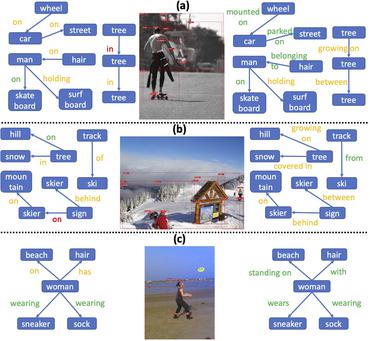Scene Graph Generation
110 papers with code • 5 benchmarks • 7 datasets
A scene graph is a structured representation of an image, where nodes in a scene graph correspond to object bounding boxes with their object categories, and edges correspond to their pairwise relationships between objects. The task of Scene Graph Generation is to generate a visually-grounded scene graph that most accurately correlates with an image.
Libraries
Use these libraries to find Scene Graph Generation models and implementationsLatest papers with no code
Expanding Scene Graph Boundaries: Fully Open-vocabulary Scene Graph Generation via Visual-Concept Alignment and Retention
For the more challenging settings of relation-involved open vocabulary SGG, the proposed approach integrates relation-aware pre-training utilizing image-caption data and retains visual-concept alignment through knowledge distillation.
Two Stream Scene Understanding on Graph Embedding
This architecture utilizes a graph feature stream and an image feature stream, aiming to merge the strengths of both modalities for improved performance in image classification and scene graph generation tasks.
Towards a Unified Transformer-based Framework for Scene Graph Generation and Human-object Interaction Detection
In light of this, we introduce SG2HOI+, a unified one-step model based on the Transformer architecture.
Semantic Scene Graph Generation Based on an Edge Dual Scene Graph and Message Passing Neural Network
Along with generative AI, interest in scene graph generation (SGG), which comprehensively captures the relationships and interactions between objects in an image and creates a structured graph-based representation, has significantly increased in recent years.
FloCoDe: Unbiased Dynamic Scene Graph Generation with Temporal Consistency and Correlation Debiasing
To address the long-tail issue of visual relationships, we propose correlation debiasing and a label correlation-based loss to learn unbiased relation representations for long-tailed classes.
VidCoM: Fast Video Comprehension through Large Language Models with Multimodal Tools
Building models that comprehends videos and responds specific user instructions is a practical and challenging topic, as it requires mastery of both vision understanding and knowledge reasoning.
TextPSG: Panoptic Scene Graph Generation from Textual Descriptions
To tackle this problem, we propose a new framework TextPSG consisting of four modules, i. e., a region grouper, an entity grounder, a segment merger, and a label generator, with several novel techniques.
Domain-wise Invariant Learning for Panoptic Scene Graph Generation
Panoptic Scene Graph Generation (PSG) involves the detection of objects and the prediction of their corresponding relationships (predicates).
Logical Bias Learning for Object Relation Prediction
Scene graph generation (SGG) aims to automatically map an image into a semantic structural graph for better scene understanding.
Predicate Classification Using Optimal Transport Loss in Scene Graph Generation
In scene graph generation (SGG), learning with cross-entropy loss yields biased predictions owing to the severe imbalance in the distribution of the relationship labels in the dataset.





 MS COCO
MS COCO
 Visual Genome
Visual Genome
 VRD
VRD
 3DSSG
3DSSG
 3RScan
3RScan
 PSG Dataset
PSG Dataset
 4D-OR
4D-OR

